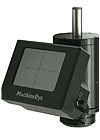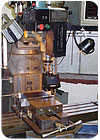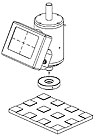
Part inspection on a machine tool is difficult because of environmental and climatic issues, but a new plug-and-inspect video measurement system can be used on a machine tool to magnify a part’s geometry for visual inspection.
The MachineEye video measuring system from MachineEye, a division of MeV Technologies LLC (Westport, CT), was developed to be an affordable alternative to coordinate measuring machines (CMMs). While it does not offer the precision of a CMM, nor generate or capture the same amount of data, the MachineEye allows parts to be visually inspected on the machine tool without having to offload the part and before additional operations are performed on the part.
“If machining a complex part with a complex part setup, the part can be inspected before it's taken off the machine, so the operator can confidently move to the next machining step knowing that the first phase of the operation was done properly,” says Milan Milosevic, chief technology officer and designer of the MachineEye inspection system.

The 4-pound and approximately 7-inch by 5-inch standard unit mounts directly on a machine tool such as a vertical milling machine, jig borer, jig grinder, sinker EDM-basically any machine tool with a vertical spindle and a table. A custom fixture can be used to mount the MachineEye to a lathe. It takes about 10 seconds to mount the video system onto the machine tool via a 5⁄8-inch shank, or a range of different shank diameters, according to Milosevic.
Using a 1⁄3-inch CMOS color camera and 40X magnification, the part surface is shown on a 4-inch TFT-LCD. The MachineEye has a working distance of 0.98 inch, a field-of-view of 0.10 inch and comes standard with a cross-hairs reticle or with custom-ordered angle and circle reticles. An illumination system has four ring-mounted white LEDs. The unit is powered by a 12-volt nickel metal hydride (NiMH) rechargeable battery pack.
The system uses the machine tool’s precision movement along the XYZ axes. Not only does this result in precise movement, it means that the size of the part to be measured is limited only by the machine tool’s travel capabilities. Whatever size part the machine tool can mill is the size of the part that can be inspected. Additionally, if the machine tool is computer numerical controlled, inspection routines can be programmed.
Because the MachineEye uses the tool’s XYZ movement to find and view the part’s surface, its accuracy is contingent on the machine tool’s accuracy.

Before the MachineEye could be successfully launched, Milosevic needed to develop a quick, cheap and accurate way to qualify the machine and so they incorporated a precision gage plate. The gage plate measures 7 inches by 5 inches with a 1-inch grid. The plate can measure the XYZ positional accuracy by lining up the starting point on the grid with the MachineEye’s crosshairs and zeroing out the position on the digital readout. By moving the machine from point-to-point on the grid, and lining up the crosshairs with the grid line points, the operator can tell if the machine is accurate.
“The gage plate can be placed on the work table to quickly check to make sure the machine is precise enough,” says Milosevic. “Users should check the machine systematically. They should check all points on the grid, which is 35 points, to be confident about the machine’s accuracy.”
The prequalification of the machine can be done prior to a run of a part or periodically to evaluate the performance of a machine. This prequalification process not only ensures accuracy during the inspection process, but determining positional accuracy also can help improve part production and help eliminate out-of-alignment and other machining problems. Milosevic says that the first customer to buy the MachineEye bought it to check his machine tools to see if calibration was needed by an outside service.
Inspection For All
Milosevic admits that the system is not a replacement for a CMM, but a portable alternative for a company that does not need ‘ultimate’ precision. “We believe this is an affordable alternative to CMMs,” he says. “As one customer describes it, the MachineEye offers ‘video inspection for the masses.’”MachineEye’s genesis goes back to Milosevic’s previous job as president of a scientific optical products company. While the company had a small, internal machine shop, 90% of all the parts were outsourced. Parts would come in and be put in the stock room. The vast majority were accurate, but occasionally the parts would be flawed; so quality control personnel using calipers would inspect each part before use. A CMM was cost prohibitive, and the shop had no room to fit the large footprint a CMM requires.
The metal parts were mostly in the shape of plates with features such as tapped holes, slots and grooves. Relatively simple parts, but inspecting them with calipers proved to be a tedious, labor-intensive process. “A good engineer might spend an hour to do one part,” Milosevic says.
After the company was sold, Milosevic and his wife Violet, who now serves as chief executive officer of the new company, founded MeV Technologies LLC, a manufacturer of scientific optical instruments, and developed the MachineEye as a division of that company. “This was the first problem that we wanted to attack,” says Violet. “Because we ran into a situation that needed such a system, we felt that there were a large number of businesses just like us who would have a similar type need.”

It is a robust system, made of precision-machined anodized aluminum alloy that can withstand some of the environmental issues found in a machine shop, he says.

Currently, the magnified image is live; it cannot be recorded or captured. Future iterations of the MachineEye may include a wireless camera to capture the images and transmit the data to a computer, PDA or other electronic device for documentation purposes or file sharing across an IP.
In addition, Milosevic is contemplating other options such as incorporating digital zoom and shape recognition software, which would facilitate automated inspection. The most ambitious idea is to work with the machine tool manufacturers to build the MachineEye directly into production machinery.
IN PROCESS OR FINISHED PART INSPECTION
Quality Specs
TECHNOLOGY CONTACT
For more information on the MachineEye, contact:MachineEye, a Div. of MeV Technologies LLC
9 Janson Dr.
Westport, CT 06880
(203) 858-3609
E-mail: [email protected]
URL: www.machineeye.com